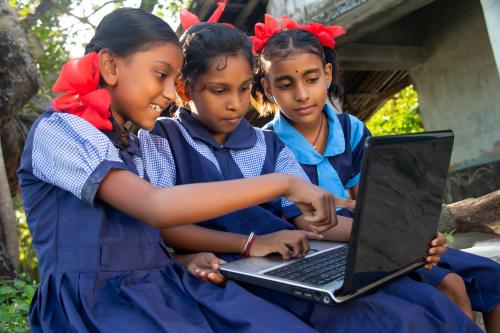While technology has transformed most industries—from air travel, to finance, to health care—it has yet to do the same in education. Before COVID-19, most school systems across the world did not look strikingly different from how they did in the 20th or even 19th centuries. And investments in ed tech had mostly focused on deploying devices and connectivity, without much regard to their use by teachers and students for learning. Thus, it is not surprising that impact evaluations of investments—for example, the “one laptop per child at home” study in Peru—found no impact on student learning.
In a recent report co-authored with Alejandro Ganimian (NYU) and Rick Hess (American Enterprise Institute), “Realizing the promise: How can education technology improve learning for all?,” we built on a simple yet intuitive theoretical framework created over two decades ago by two of the most prominent education researchers in the United States, David Cohen and Deborah Ball. They argued that the main reason so many school reforms had failed in the U.S. is the failure to pay adequate attention to what matters most to improve learning: the interactions between educators and learners around educational materials—what they termed the “instructional core.”
My co-authors and I argue that the failed school-improvement efforts in the U.S. that motivated Cohen and Ball’s framework resemble the ed-tech reforms in much of the developing world in the lack of clarity around improving the interactions among educators, learners, and the educational material. We built on their framework by adding parents as key agents that mediate the relationships among learners, educators, and the material.
After an extensive review of the evidence showing how ed-tech interventions are effective in improving student learning in low- and middle-income countries, we concluded that ed tech is most effective when it complements, not substitutes, the work of teachers. Specifically, we found that ed-tech interventions are most effective when they play to one or more of its comparative advantages: (1) scaling up quality instruction; (2) facilitating personalized instruction; (3) expanding opportunities for practice; and (4) increasing learner engagement (making it more fun to learn!).
What is perhaps most troubling is that as countries are reopening schools, they are going back to how education was delivered before the pandemic, instead of seizing the opportunity of the disruption to transform education.
This framework is even more useful now to understand the impact of the COVID-19-related school closures on student learning, and how (or to what extent) ed tech has been able to mitigate learning losses.
Ed tech and mitigating learning loss
Almost a year ago, I worked with another group of co-authors (George Psacharopoulos, Harry Patrinos, and Victoria Collis) to build on previous research by Harry and George on the economic returns to education around the world to estimate the impact on learning losses and productivity using various scenarios of length of school closures. Our goal was to send a message to policymakers about the urgent need to reopen schools. Our research, which was published in the April 2021 issue of the Comparative Education Review, estimated that the learning losses due to school closures were likely to lead to a reduction in global economic growth equivalent to an annual rate of 0.8 percent. This represents a total loss in constant U.S. dollars of a staggering $15 trillion. And, in absolute dollars, the losses are greatest in high-income countries, where learning levels and productivity tend to be higher. But over a cohort of students’ lifetimes, the losses as a share of GDP are much greater for students in low-income countries (62 percent) as compared to students in middle- (22 percent) and high-income (9 percent) countries. Using different assumptions and models, researchers at the World Bank and OECD have produced similar estimates.
But, a year later, we are seeing a series of empirical analyses of actual learning losses (as opposed to estimates), using data from students who missed out on school in various countries with varying levels of access to digital infrastructure, connectivity, and devices—and what we are seeing from this emerging evidence is sobering.
For instance, the Netherlands is a country that was relatively well equipped for online education, as 96 percent of Dutch households have access to the internet at home. While like most countries, the Netherlands closed schools in mid-March of 2020, it reopened them on May 11 of that year, and until June 7, children went to school part time to make groups smaller and easier to maintain social distance. Beginning on June 8, schools reopened at the regular schedule. By contrast, many countries in the developing world—including in South Asia, Africa, and Latin America, and the Caribbean—closed schools in mid-March and did not begin to reopen them until at least a year later.
Despite the Netherland’s favorable conditions, a recent evaluation of learning growth among Dutch students found lower learning gains during the COVID-19 pandemic compared to the growth of students in previous cohorts. Dutch students in grades one through five during 2020-2021 experienced average learning losses ranging from 0.06 to 0.20 standard deviations in reading and 0.13 to 0.33 standard deviations in math.
While these are average learning losses, the research finds evidence of growing inequality, as students with less-educated parents and students from lower-income households experienced greater learning losses than their counterparts with more educated parents and from higher-income households. These larger learning losses compound previous already lower learning levels among the poor and children with parents with lower education levels. (Interestingly, there were no differences among students from migrant families or by gender).
Recall that the Netherlands was well equipped for online learning and had relatively short periods of school closures. In contrast, in South Asia, Africa, and Latin America, many countries kept schools closed for more than one year, and some continue to keep schools closed two years after the onset of COVID-19 (Peru is an example). And few countries had the access to devices and connectivity of the Netherlands. For example, in April 2020, I wrote a Brookings report documenting that less than 25 percent of low-income countries were providing any type of remote learning, and of these, the majority were using TV and radio. In contrast, close to 90 percent of high-income countries were providing remote learning opportunities, nearly all of which were online. One notable exception is Uruguay, which over 15 years ago introduced a national one-to-one laptop/tablet program with connectivity for primary and secondary students. And, also exceptionally for the Latin American region, Uruguay began reopening schools in June of 2020.
A missed opportunity
However, what is perhaps most troubling is that as countries are reopening schools, they are going back to how education was delivered before the pandemic, instead of seizing the opportunity of the disruption to transform education. For example, in Uruguay, as the government prepares to reopen schools again for the 2022-23 academic year, no reforms to the traditional curriculum or instructional methods—for example, by integrating technology in classrooms as opposed to using it primarily outside of them—have been announced.
And there is still much to learn from exactly how different uses of ed tech at scale affected student learning during the school closures. While there are some rigorous evaluations of small-scale interventions (for example, the use of mobile phones and texting to reach primary-school students’ parents to mitigate learning losses in basic numeracy in Botswana), there are few evaluations of programs that were delivered at scale—for example, TV, radio, and online instructional platforms.
While the disruptions caused by COVID-19 offered an historic opportunity to learn about what works at scale to transform education systems and realize the promise of education technology, it seems now that this is unlikely to happen, at least in a majority of low- and middle-income countries. This is truly a missed opportunity that will have lasting impacts on generations to come.
The Brookings Institution is committed to quality, independence, and impact.
We are supported by a diverse array of funders. In line with our values and policies, each Brookings publication represents the sole views of its author(s).








Commentary
Education technology post-COVID-19: A missed opportunity?
March 11, 2022